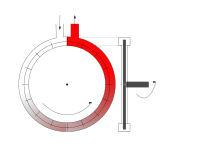Peripheral pump
A peripheral pump (also called a peripheral pump or turbine pump ) is a centrifugal pump in which the medium is conveyed by generating a flow in a peripheral ring channel.
principle
The actual pump is made up of the pump housing with two adjacent openings and the pump impeller ( impeller ), which, driven by a shaft , rotates in the housing. The impeller consists of a disk which is equipped on its periphery with straight blades that are aligned radially and transversely to the direction of rotation. In the ring channel , that is, the peripheral space of the housing between the housing wall and the impeller intended for the pumped medium, the kinetic energy of the drive shaft is transferred from the blades to the medium, causing the medium to flow. Since the ring channel between the two openings of the pump housing is narrowed, a pressure gradient is created against the direction of rotation of the impeller: a negative pressure (suction) is created at one opening of the pump housing, the intake port, and an overpressure at the other opening, the drainage port . The working principle is similar to that of a side channel pump .
properties
Peripheral impeller pumps are particularly suitable for small delivery rates and high delivery pressures. The greatest drive energy is required at the highest delivery pressure and the lowest delivery rate. This type of pump only requires a low inlet head ( NPSH ) and is independent of the direction of rotation, which means that the suction and discharge connections are not determined by the design, but change with the direction of rotation of the impeller. Peripheral impeller pumps are also manufactured in a hermetic design with a magnetic coupling .
curve
In contrast to the characteristic curve of conventional centrifugal pumps, the characteristic curve of a peripheral impeller pump does not flatten as the delivery volume decreases. Rather, the characteristic curve is a straight line with maximum delivery head at zero delivery and zero height at maximum delivery. This straight line results from the fact that the peripheral pump is of the volume displacement type.


